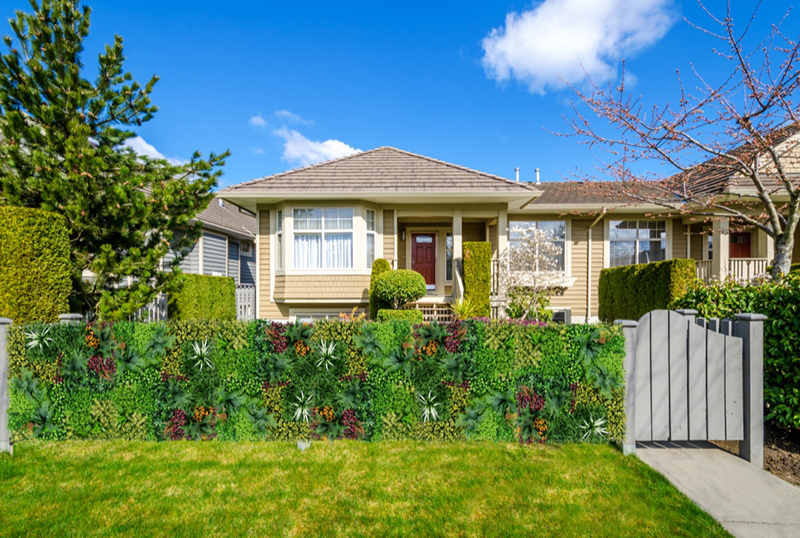Foliage Plant Pairings for 3D Artificial Vertical Gardens: Designing Lush, Textured Green Walls for Any Space
Artificial vertical gardens provide an excellent canvas for showcasing a diverse range of leaf shapes, colors, and textures, creating visually striking displays that mimic the beauty of real foliage plants. Unlike living plants, artificial designs require no sunlight, water, or pruning, making them ideal for low-light interiors, high-traffic areas, or spaces with challenging environmental conditions. Below are strategies for combining artificial foliage plants to achieve a dynamic, layered, and visually appealing 3D vertical garden.

One of the key principles of successful foliage plant pairings is incorporating a variety of leaf shapes to add depth and interest. Artificial designs can replicate the organic diversity of real plants without the constraints of growth habits or seasonal changes.
Broad, Oval Leaves as Anchors: Use artificial plants with large, rounded leaves, such as those inspired by philodendron or monstera, as focal points in the arrangement. These bold shapes create a sense of stability and serve as a backdrop for more delicate plants.
Long, Slender Leaves for Vertical Movement: Incorporate artificial plants with narrow, elongated leaves, like those resembling snake plants or dracaena, to add height and flow. These designs draw the eye upward and create a sense of vertical energy.
Small, Rounded Leaves for Fillers: Scatter artificial plants with tiny, compact leaves, such as those mimicking ferns or pilea, throughout the arrangement to fill gaps and add texture. These subtle accents prevent the garden from looking sparse or artificial.
Real foliage plants display a wide range of greens, from deep emerald to bright lime, along with occasional hints of yellow, silver, or purple. Artificial designs can draw from this natural palette to create a harmonious and lifelike appearance.
Deep Greens for Depth and Drama: Place artificial plants with dark, rich green leaves, like those inspired by rubber plants or ZZ plants, in the center or lower sections of the arrangement. These shades create a sense of grounding and contrast with lighter-colored plants.
Light Greens and Chartreuse for Brightness: Use artificial plants with pale green or yellow-green leaves, such as those resembling pothos or spider plants, to add a pop of color and energy. These hues work well in upper sections or near the edges of the garden.
Variegated Leaves for Visual Intrigue: Incorporate artificial plants with leaves that feature streaks, spots, or edges of white, cream, or yellow, like those mimicking calathea or aglaonema. These patterns break up solid blocks of color and add a touch of complexity.
Texture is a critical element in creating realistic-looking artificial foliage gardens. By mixing smooth, rough, glossy, and matte surfaces, you can mimic the diversity of real leaves and add depth to the arrangement.
Smooth, Glossy Leaves for Reflection: Use artificial plants with shiny, polished leaves, like those inspired by fiddle-leaf figs or croton, to catch the light and add a sense of vibrancy. These designs work best in well-lit areas or near windows.
Rough, Matte Leaves for a Natural Feel: Incorporate artificial plants with textured, non-reflective leaves, such as those resembling succulents or some types of ferns, to add a tactile quality. These surfaces evoke the look of real plants that have adapted to dry or shaded environments.
Velvety or Fuzzy Leaves for Softness: Introduce artificial plants with soft, downy leaves, like those mimicking lamb’s ear or certain types of begonias, to add a delicate touch. These designs contrast with rougher textures and create a sense of balance.
In natural settings, plants grow in layers, with some species occupying the foreground, others the middle ground, and still others the background. Artificial gardens can replicate this layering effect to create a three-dimensional, immersive display.
Foreground Plants for Detail and Interest: Place shorter, more detailed artificial plants, such as those with intricate leaf patterns or small flowers, in the front of the arrangement. These designs draw viewers in and add a sense of intimacy.
Middle-Ground Plants for Volume and Fullness: Use medium-height artificial plants with broad or abundant foliage, like those resembling peace lilies or bird’s nest ferns, to fill out the middle sections. These plants create a sense of lushness and connect the foreground to the background.
Background Plants for Height and Structure: Incorporate taller artificial plants with upright growth habits, such as those inspired by palm fronds or bamboo, in the back of the arrangement. These designs provide a sense of scale and frame the entire garden.
By focusing on leaf shape contrast, color variations, textural diversity, and layered arrangements, artificial foliage plants can transform 3D vertical gardens into vibrant, low-maintenance displays. Their durability and adaptability make them ideal for any space, ensuring year-round beauty without the need for sunlight, water, or ongoing care.
Contact: Amy
Phone: 86-15311787313
E-mail: info@foszmac.com
Whatsapp:86-15311787313
Add: Fengtai District, Dacheng Road, No.24 Building, Room 203, Beijing, China